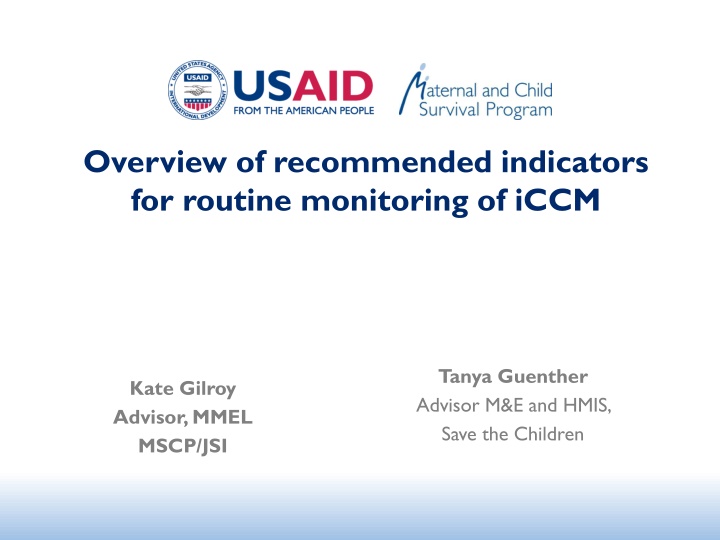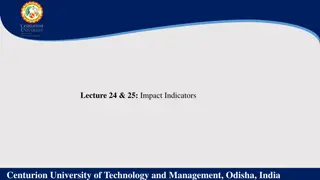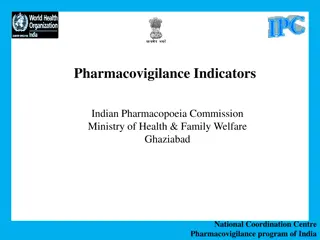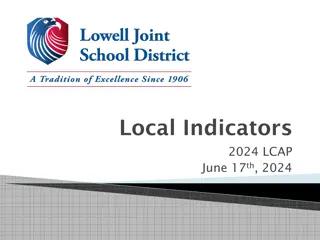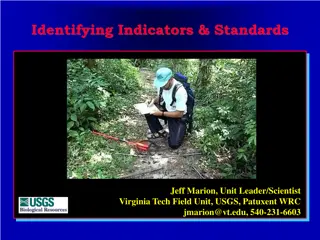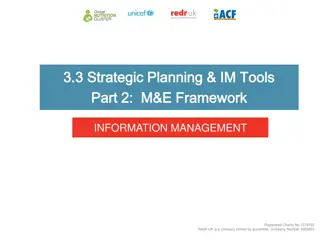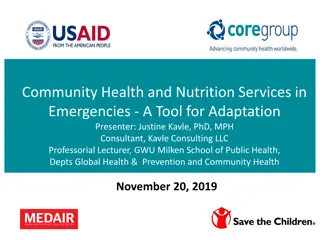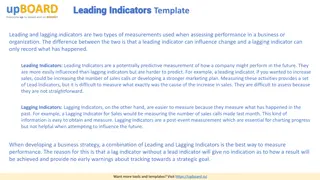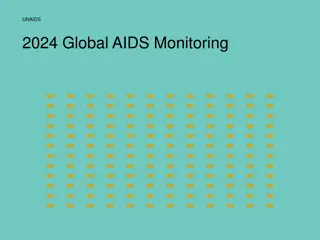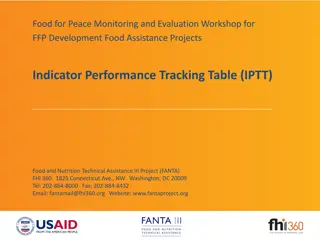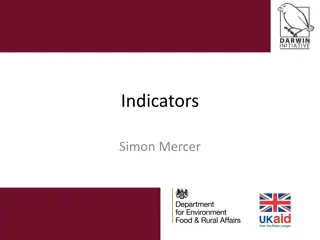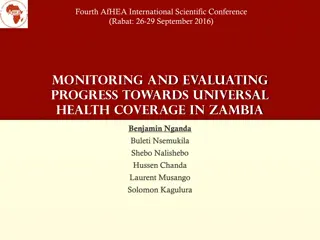Overview of Recommended Indicators for Routine Monitoring of iCCM
Process to review and refine iCCM indicators for routine monitoring initiated by the M&E sub-group of the global CCM Task Force. The group developed a list of 10 indicators in 6 domains, including Human Resources, Referrals, Service Delivery, Reporting, Supply Chain, and Clinical Coaching. These indicators aim to improve data collection and inform decision-making for iCCM implementation at every level. High-value iCCM indicators are recommended to be integrated into national HMIS for efficient monitoring and evaluation.
Download Presentation

Please find below an Image/Link to download the presentation.
The content on the website is provided AS IS for your information and personal use only. It may not be sold, licensed, or shared on other websites without obtaining consent from the author.If you encounter any issues during the download, it is possible that the publisher has removed the file from their server.
You are allowed to download the files provided on this website for personal or commercial use, subject to the condition that they are used lawfully. All files are the property of their respective owners.
The content on the website is provided AS IS for your information and personal use only. It may not be sold, licensed, or shared on other websites without obtaining consent from the author.
E N D
Presentation Transcript
Overview of recommended indicators for routine monitoring of iCCM Tanya Guenther Advisor M&E and HMIS, Save the Children Kate Gilroy Advisor, MMEL MSCP/JSI
Process to Review and Refine iCCM indicators for Routine Monitoring The M&E sub group of the global CCM Task Force started a process in Aug 2015 of reviewing the indicators and defining routine data needs at every level of iCCM implementation Developed an initial list of indicators and criteria for prioritizing the routine indicators
Process to Review and Refine iCCM indicators for Routine Monitoring Feedback on list of proposed indicators sought from other CCM TF subgroups and the Steering Committee representing a wide range of partners supporting iCCM. The sub group has proposed a set of 10 indicators in 6 domains to be collected through routine systems: Human Resources (3) Referrals (1) Service Delivery (3) Reporting (1) Supply Chain (1) Clinical coaching (1) The sub group urges countries to identify opportunities to include these high value iCCM indicators in the DHIS or other national HMIS.
Routine Indicators: Human Resources 1. Catchment population per ICCM CHW: Total population and estimated # of children under five per CCM site 2. iCCM program coverage for target population: Percentage of target communities (target population) with access to iCCM services 3. CHW to supervisor ratio: Ratio of CHWs deployed for CCM to CCM supervisors Measurement notes: Data collected/updated annually Countries to define eligibility of target communities for iCCM Requires information on CHW and CHW supervisor training and deployment and population data for target communities
Routine Indicators: Service Delivery 1. iCCM case load by CHW: Average number of cases under five years of age seen for iCCM by CHW by report period 2. iCCM treatment rate: Number of ** cases under five years of age treated by CHWs per 1,000 children under five years of age in target areas in a given time period a) RDT+ Malaria b) Suspected Pneumonia (cough or difficulty breathing with a high respiratory rate for age) c) Diarrhea (can report ORS, zinc and ORS+zinc) d) Severe Acute Malnutrition e) Moderate Acute Malnutrition Only recommended where CHWs are treating SAM and MAM 3. RDT positivity rate: Percentageof fever cases under five years of age presenting to CHW who were tested with RDT and received a positive result Measurement notes: CCM treatment rate indicators enable routine assessment of utilization in iCCM target areas. Should be examined in comparison with the expected number of cases to draw inferences about estimated coverage of CHW treatment
Routine Indicators: Supply Chain 1. Medicine and diagnostic availability: percentage of CHWs with all key iCCM medicines and diagnostics in stock on last day of reporting period low osmolarity ORS and zinc supplements for diarrhea amoxicillin for pneumonia ACTs and RDTs (where appropriate) for fever/malaria in malaria- endemic countries others required by program (tailor to each country s needs) Measurement notes: SC group recommends countries work toward capturing continuous stock availability (% of CHWs with no stockouts in the past month) to gain a more complete picture of product availability Countries may opt to identify 1-2 items as tracers to limit reporting burden and focus attention
Routine Indicators: Referrals 1. Referral rate: number of iCCM cases under five years of age recommended for referral by the CHW per 100 iCCM cases under five years of age seen by CHW Measurement notes: Reasons for referral will often include danger signs or stock-outs No benchmark value exists; countries need to establish range and follow-up to determine reasons behind low or high values Does not capture how well CHWs identify danger signs, whether referrals are made correctly, nor whether the referred child is actually taken to a health facility for care Special studies are recommended to better understand referral
Routine Indicators: Reporting Reporting level: percentage of expected reports with iCCM data received during time period Measurement notes: Disaggregate by level (CHW, health facility, district) Does not provide information on the timeliness or quality of the data nor whether the data are being used by district, facility staff or CHWs to inform decision-making about CCM programs. Countries using DHIS2 may be able to track whether reports were received by reporting date Periodic data quality audits are recommended to evaluate data quality and identify areas for improvement
Routine Indicators: Clinical Coaching Clinical coaching/mentorship: percentage of CHWs who received clinical coaching/mentorship* in iCCM during reporting period; * - to be defined locally' Measurement notes: Definition of clinical mentorship/coaching activities will need to be determined by countries. Clinical mentorship and coaching activities are those that review and discuss the CHW quality of services and quality and accuracy of data completeness Does not provide information on the quality of the mentorship or coaching, nor does it indicate whether the treatment of the sick child was considered appropriate
Next Steps M&E subgroup is close to finalizing indicator reference sheets that provide detailed information on definition, rationale, data sources and methods, interpretation and caveats. Will disseminate online and through meetings, conferences, workshops etc. Working to develop supporting tools (e.g. sample registers and reports; DHIS2 dashboards and visualization aids) Collaborating with other global initiatives to harmonize recommended indicators at community level (Global Data Collaborative, Global Fund, etc.) Please send your comments on these recommended indicators to kate_gilroy@jsi.com
For more information, please visit www.mcsprogram.org This presentation was made possible by the generous support of the American people through the United States Agency for International Development (USAID), under the terms of the Cooperative Agreement AID-OAA-A-14-00028. The contents are the responsibility of the authors and do not necessarily reflect the views of USAID or the United States Government. facebook.com/MCSPglobal twitter.com/MCSPglobal
